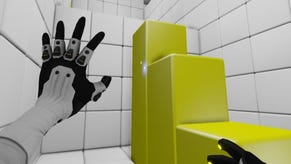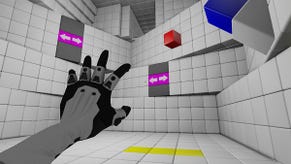Wot I Think: Q.U.B.E.
Quality Underlies Banal Exterior?
An uncanny piece of scientific equipment. A series of sterile test chambers. A first-person puzzle game that demands spatial awareness and the precise handling of increasing combinations of elements. It’s Q.U.B.E. and this is Wot I Think.
Sooner or later I’m going to mention Portal and I’d rather do it here, get it out of the way, and move on to talk about the Indie Fund's first release instead. Here's why Portal is looking over my shoulder. Q.U.B.E. a first-person puzzle game, of which there are few, and it takes place in a mysterious and sinister testing environment. Each room is a challenge that builds on what has already been taught. The sorscerientific gloves that act as the sole means of interacting with the world allow strange manipulation, triggering reactions in objects from afar. It’s cube- and button-based testing with a lot more cubes and a lot less buttons.
Many of those similarities are aesthetic and the actual puzzles require very different thought processes than those over at Aperture, including a particular process that involves me gesturing violently toward the screen, quitting the game and walking away, and then returning five minutes later and solving the room in less than a minute.
The later, more complex tasks can often become convoluted, with the motions of several different blocks and changes in the rooms themselves becoming entangled, and making it all too easy to reach a point from which the correct path seems lost entirely. Thankfully, most of the cube-packed rooms contain a reset button, taking them back to their original state, and there is usually, perhaps always, one correct path. That's not a bad thing in this case - it suits the precision of control and positioning the game is built around.
Here’s how it works. Almost everything is portrayed at the washed-out and slightly polished periphery of the grayscale, including the technogloves on your hands. Then there are the blocks, which come in a variety of bright and attention-grabbing colours. Look at them and nodes on the gloves light up with the same colour – a bond of sorts is formed. Depending on the colour of the block, activating the gloves will cause it to move, or activate, in a certain fashion. Initially, it’s all quite simple. Red blocks can be pulled out of the wall, extending to make platforms or to push/block other objects. Blue blocks, when pushed into the wall they are embedded in, become a spring, coiled to launch whatever touches them next.
Soon there are quite a few others, including blocks which are essentially buttons that rotate sections of a room. The pace at which new ideas are introduced is steady and there’s nothing that felt confused, despite the lack of explanations. Learning is achieved by doing and that’s as it should be. There are no voices to guide and no cryptic messages or manuals lying around the place. The lack of an instructor, murderous or not, makes one more Portal mention worthwhile. There’s none of that here, the quipping, the teasing and the bullying. In Q.U.B.E., you are very much left alone with your devices.
As in the first Portal, progression is through puzzle solutions rather than plotting for most of the game, but without the characterisation and comedy that sometimes spurred me on more than the portalling itself. Perhaps I have a childish brain but it usually wants a treat after doing some work, even if the work itself is pleasurable in a way. A bit of banter with a psychotic AI, or even some vague suggestion as to a bigger picture, that’s all I want. Something to suggest the designers of a puzzle are proud of me and want to reward me for my efforts by entertaining me or providing something unexpected.
Q.U.B.E. tends to reward the discovery of a solution with the presentation of a more difficult problem and even though most of the rooms are cleverly designed, there aren't enough tiny epiphanies and before the end of the short duration I was hankering for more involvement.
Part of the problem lies with the gloves themselves. They have no personality and, yes, I’m arguing that technology should have personality. There’s an animation that plays at the beginning of the game, one which is familiar from so many first person games; it’s the one where the item held is angled and studied, denoting the curiosity and amazement of the person holding it. Angry men-shootists do it when they find a particularly large gun and intrepid explorers cannot help but perform it when discovering alien technology. That’s about as much as the game feels the need to tell us about the gloves. They inspire an animation that suggests they are a powerful mystery to the wearer.
That would be fine, except that they could well be a gun or a laser pen, or a bionic eye. There’s nothing about their gloveness that actually matters, since they’re not used for tactile interaction or gripping. They are a pointing device, just as the reticule on the screen is. That brings into question the role of the player character and their physicality in the chambers.
The reason the game wouldn’t work as a more abstract design, with the player reduced from a man/woman/cyborg to a cursor, is because the solution to puzzles often involves creating a path to the room’s exit. Given that cubes essentially move on a grid there are a number of fixed combinations in every rooms so the process of creating the route is the brainwork, actually navigating it afterwards is perfunctory and there's little to see or discover in the environments beyond the puzzles themselves.
My favourite parts of the game are the sections that almost entirely ignore player movement and positioning. Certain rooms contain balls, which must be guided into an energy field, or a series of differently hued energy fields. Only one is active at a time and using all the different kinds of cube in the room, it’s necessary to construct tracks that nudge, bump and guide the balls into the correct position. Once all the necessary fields have been activated, a door will open or stairs will appear, but there may as well just be a ‘level solved’ screen.
What’s my point? I suppose I’m distracted by the bits and pieces that allude to a scenario and find them unfulfilling. Preferably, all puzzle games would greet me with narrative interludes but there are times when colours and shapes are nothing more than colours and shapes. They don’t have to be. Q.U.B.E. is a game about colours and shapes, not about laboratories and gizmos. It’s also a fairly good game about colours and shapes that doesn’t run its ideas into the ground but also offers very little reason to revisit.
The demo is too short to be altogether helpful. The full game sticks to its single concept but has enough ideas that it doesn’t recycle solutions all that often. There are some frustrating timing issues, when a rotation or extrusion must occur a little too precisely, but there aren’t a great many brick walls. And this is coming from someone who has the spatial awareness of a baby giraffe recently released from a large tumble dryer. I’ve never seen such a thing but I’m guessing it would stumble and bump into things and struggle with its awkward proportions even more than normally. That’s me. But I was OK in Q.U.B.E., even though it may have taken me quite a bit longer than most people.
And I enjoyed it. I even like the way it looks – crisp, clean and with no confusion. I doubt I’ll ever play it again and I won’t feel compelled to wait for DLC, free or otherwise, because I think I've about had my fill. There’s nothing about the concept that particularly amazed or excited me; it’s a series of well-designed puzzles that avoid too much repetition but never really become tough enough to provide total satisfaction.


















